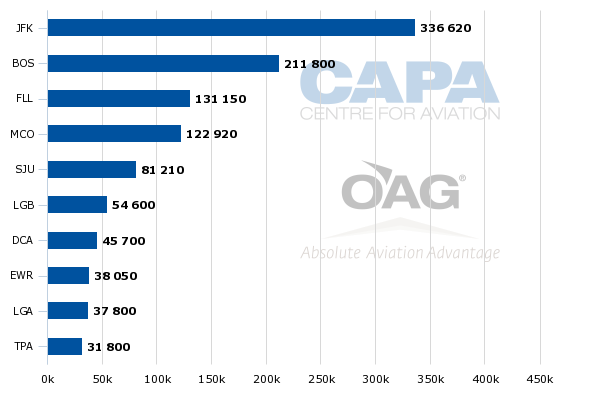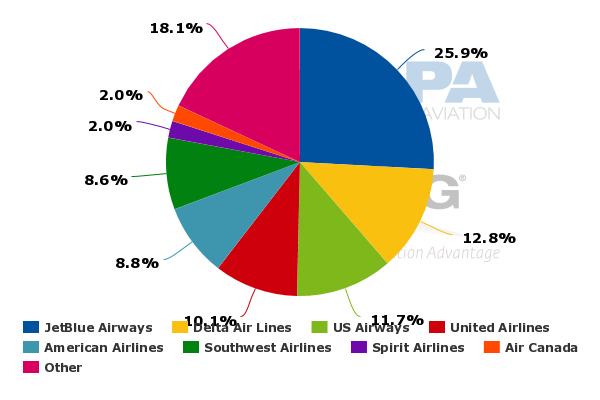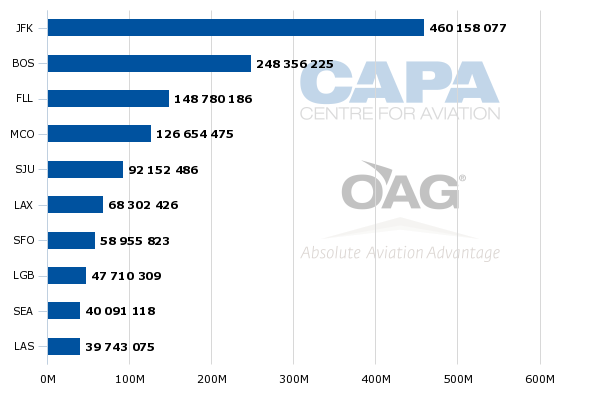JetBlue Airways raises the competitive bar in Boston with new Mint service. Will its rivals respond?
JetBlue Airways plans to spread its Mint premium service to the Boston market in 2016, a move that is unsurprising given part of its premise in transforming the airport into a focus city starting in 2007 was expanding its corporate traveller base.
JetBlue is now Boston Logan International Airport's largest airline, and has worked hard over the last few years to grow its corporate share in the market. The addition of Mint is a natural progression in that strategy. The question now is how will its rivals respond to Mint's introduction in Boston.
With so much competition now in the New York transcontinental markets, and with those routes serving as some of the most lucrative in the US market, JetBlue's competitors in Boston for now may opt to wait and see how the market responds to a flatbed product.
Boston Logan appears a logical market for Mint expansion
JetBlue has arguably disrupted the highly contested New York transcontinental market from JFK to Los Angeles and San Francisco with its Mint service - a sub-fleet of 11 Airbus A321s featuring 16 flatbed seats, four of which are closed off private suites. Since its debut in those markets in 2014, JetBlue has touted the success of Mint, highlighting improved profit margins on its New York flights.
Mint was no doubt one of the drivers in United's decision to move its premium p.s. service from JFK to Los Angeles and San Francisco to its Newark hub. Other rivals have cited pricing dilution in the market since Mint's debut. JetBlue designed Mint to target passengers that preferred a higher level of service, but couldn't afford the regular business class fares other airlines charged on the transcontinental flights.
See related report: United Airlines' moves in New York reflect the heightened competition in the market
Even before Mint made its formal debut in mid-2014, JetBlue's previous CEO Dave Barger observed that Boston was another potential market for Mint service. Part of JetBlue's rationale for transitioning Boston into a focus city was to diversify from its leisure and VFR passenger base and increase its corporate customers. A more diverse passenger mix allows the airline to withstand the typical seasonal troughs in leisure and VFR travel.
Boston is JetBlue's second largest base measured by seats and ASMs, and the airline is Boston's largest in both of those metrics.
JetBlue Airways global top 10 hubs/bases/stations by seats: 29-Jun-2015 to 5-Jul-2015

JetBlue Airways global top 10 hubs/bases/stations by ASMs: 29-Jun-2015 to 5-Jul-2015

JetBlue estimates in Jan-2016 it will operate 118 daily departures from Boston, double its offerings of 54 daily flights in 2008.
By the summer peak travel season in 2016, JetBlue projects operating 140 daily flights from Boston.
Boston Logan International Airport capacity by airline (% of seats): 29-Jun-2015 to 5-Jul-2015

Boston Logan International Airport capacity by airline (% of ASMs): 29-Jun-2015 to 5-Jul-2015

Are JetBlue's rivals on Boston transcon routes concerned about Mint?
It is likely that eventual service from Boston played a factor in JetBlue's calculus for creating and deploying Mint, and with roughly a year of operation in the New York market JetBlue is now ready to deploy its Mint product from Boston in 2016.
It plans to add three daily Mint services to Los Angeles in autumn of 2016 and three to San Francisco in Mar-2016. Los Angeles and San Francisco are the two largest domestic markets from Boston measured by ASM deployment, and the fifth and six largest measured by seats.
Boston Logan International Airport top 10 domestic routes by seats: 29-Jun-2015 to 5-Jul-2015

Boston Logan International Airport top 10 domestic routes by ASMs: 29-Jun-2015 to 5-Jun-2015

Data from CAPA and OAG show that for the week of 29-Jun-2015 there are roughly 14,660 one-way seats deployed between Boston and Los Angeles. American has a 32% share, JetBlue 21%, Virgin America 18%, United 15% and Delta 13%. From Boston to San Francisco, there are approximately 14,650 seats offered on the pairing. United represents 55%, Virgin America 23% and JetBlue 21%.
American operates Boeing 737-800s from Boston to Los Angeles, according to CAPA and OAG, United operates a p.s. 757-200 (with flatbed seats) and 737-900s and Delta operates 737-800s. Virgin America operates A319s and A320s and JetBlue operates A320s. Between Boston and San Francisco, United operates Airbus A320s and 737-800s/900s, JetBlue operates A320s and Virgin America operates A320s.
Once JetBlue adds its three daily Mint flights from Boston to Los Angeles and San Francisco, it will deploy roughly 336 one-way flatbed seats (based on 3x a day Monday-Sunday) on those routes. United has been operating a single daily flight between Boston and Los Angeles with a p.s. 757-200 featuring 28 flatbed seats since Jun-2015 and plans to continue through mid-Aug-2015. But aside from that limited service, no other airline offers flatbed seats on those routes. They offer a business or first class section with seats that recline rather than are fully flatbed.
JetBlue should be able to capitalise on its point of sale strength in Boston to sell the Mint product, although the corporate base in Boston is obviously smaller than New York, and could need some initial price stimulation. But the airline has also no doubt done research among its corporate clients in Boston to determine if there is enough demand for Mint at certain price points.
Now JetBlue's rivals need to decide if it is worth the investment to add their own premium service in Boston. Delta is the second largest airline in Boston, but the smallest carrier from Boston to Los Angeles measured by seats, and seems to be focussed on intensifying competition with JetBlue on Mint service from JFK to Los Angeles and San Francisco with planned increases on those routes in Nov-2015.
American is the largest airline in the Boston-Los Angeles market; but with the competition occurring in the New York transcontinental market, it may opt to keep its 17 A321T aircraft operating on those routes. American is the only airline to have a dedicated first class from New York to Los Angeles and San Francisco, and presumably that product fetches more high yielding customers than it could garner in the Boston market.
United is the one wildcard as it is reconfiguring some of its trans-Atlantic 757-200s into the p.s. configuration for bulked up service from Newark to Los Angeles and San Francisco. But those aircraft could be deployed in Boston at some point if United feels that Mint is cutting into its corporate passengers. For now its seems United has more opportunity for its premium product at its Newark hub, where it can foster connections to its vast network from its east coast gateway.
Virgin America could be the most vulnerable competitor to Mint's debut in Boston. JetBlue will no doubt offer attractive initial price points for the Mint service in Boston, which may cause some of Virgin America's premium passengers to at least try the Mint service.
JetBlue adds Nashville and ups frequencies in Boston
Once JetBlue reaches its 140 daily departures from Boston in the winter 2016 timeframe, it will be close to its stated goal of 150. It is bolstering its presence in several markets, increasing daily flights to Orlando, Fort Lauderdale, Tampa, San Juan, Raleigh-Durham, JFK and Cleveland. It is adding more weekend flights to its Caribbean network including, Barbados, Aruba, Turks and Caicos, Cancun and Punta Cana. It also plans to add weekend service to Liberia, Costa Rica.
Additionally, JetBlue is adding a new market from Boston with new service to Nashville beginning in the spring of 2016, breaking Southwest's monopoly on the route.
Mint could push JetBlue's margins in Boston even higher
JetBlue stands to be one of the few US airlines that will actually post gains in unit revenue for 2Q2015. That is commendable given the investment and resources necessary to deploy Mint in a fairly short period of time. The product has been a disruptor in the New York transcontinental market, and its chances of success in Boston are fairly robust given that the market had margins that expanded three points higher than JetBlue's system average for the 12M ending Mar-2015.
Mint remains in its early stages, but the popular response is strong and for now it seems to be delivering on its purpose of eroding JetBlue's structural disadvantage in the New York transcontinental market. Perhaps it can bolster Boston's margins even further.